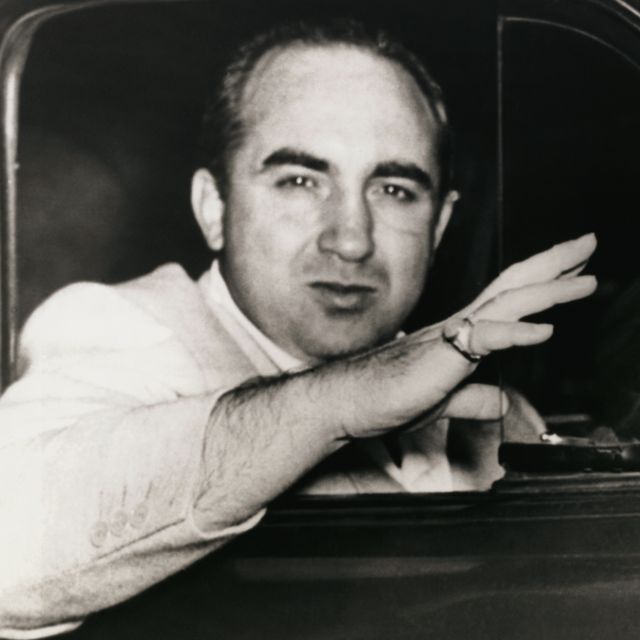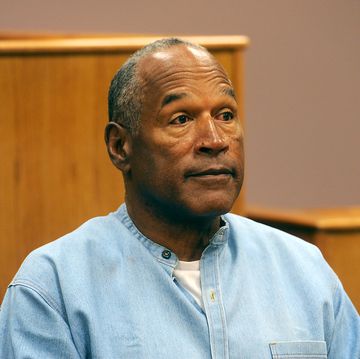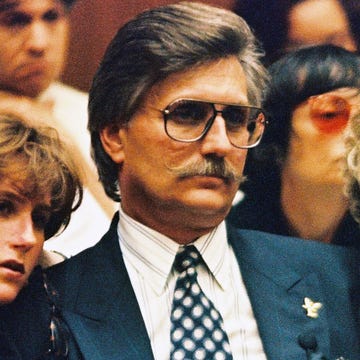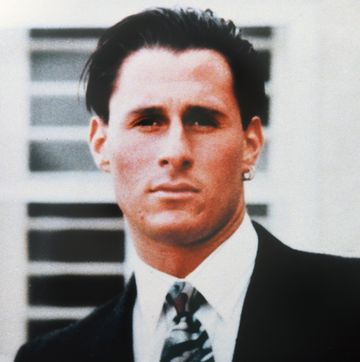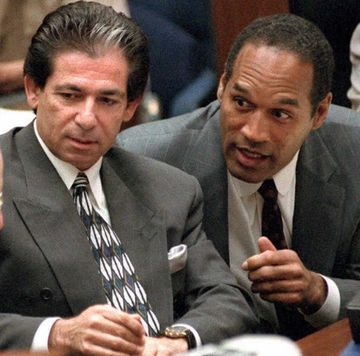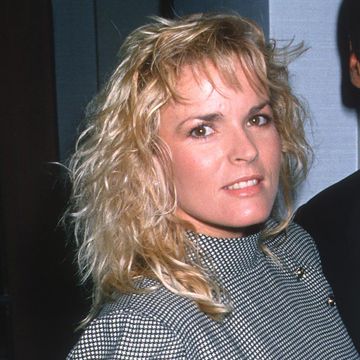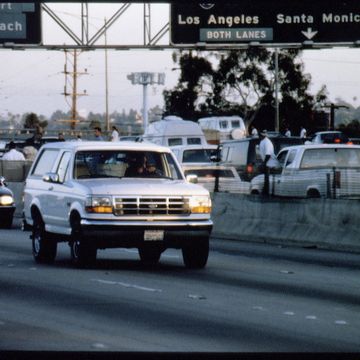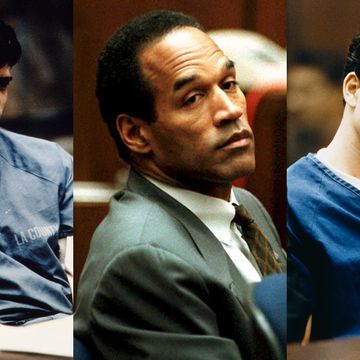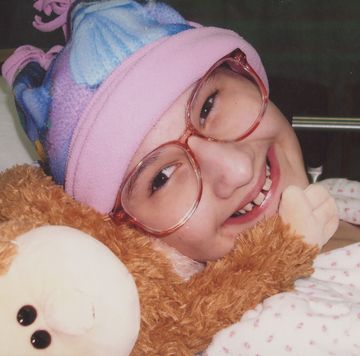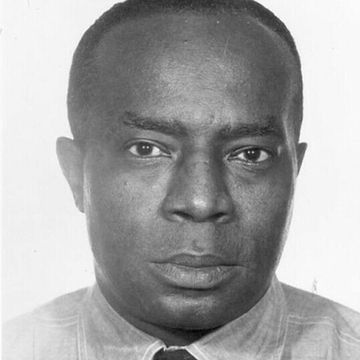(1913–1976)
Who Was Mickey Cohen?
Mickey Cohen was born in Brooklyn, New York, and grew up in Los Angeles. After a troubled childhood, Cohen's first connections with top Jewish and Italian mobsters came during his teenage years, through his involvement in the boxing game. In his early 20s, he began working for legendary mobster Bugsy Siegel. By the early 1940s, Cohen was allied with Siegel's partners Meyer Lansky and Frank Costello; approved by Lucky Luciano; and sponsored by his old Cleveland supporters, the Milano family, along with other prominent nationally ranked mobsters. In 1947, Siegel was assassinated and Cohen, subsequently, became the West Coast crime boss. His connections were so wide and deep that although he was brought to trial for all types of offenses, including murder, he was convicted just twice, for income tax evasion.
Quick Facts
FULL NAME: Mickey Cohen
BORN: September 4, 1913
DIED: July 29, 1976
BIRTHPLACE: Brooklyn, New York
ASTROLOGICAL SIGN: Virgo
Early Life
Cohen was born Meyer Harris Cohen on September 4, 1913, in the Brownsville neighborhood of Brooklyn, New York. He moved to Los Angeles, California, as a toddler with his widowed mother, a Russian-Jewish immigrant who spoke little English. With five older siblings, Cohen grew up poor in Boyle Heights, a tough melting pot neighborhood in Los Angeles. His hardworking mother ran a tiny grocery, and during Prohibition, his brothers operated a drug store, where he learned to make bootleg alcohol.
Rarely in school, Cohen grew up illiterate and barely supervised. Without proper guidance, he developed a skewed moral compass, and constantly looked for ways to make money, legally or illegally. He was a veteran of two stints in reform school by age ten. He sold newspapers in the downtown financial district and boxed in amateur bouts. He ran away from home at age 15, and lived in Cleveland, then in New York and Chicago. As the Great Depression hit, young Cohen boxed professionally and later acted as a freelance bandit and an enforcer aligned with major mobsters.
Early Mob Roles
After troubles erupted in Cleveland, the mob syndicate placed Cohen in Chicago where Cohen ran his own armed burglary crew and worked in small jobs on the illegal gambling circuit for the Chicago outfit, made legendary by Al Capone. While many sources, including Cohen himself, claim that he and Capone met, there is no conclusive evidence of this. A personal meeting between the two would have been highly unlikely, however, as Capone was in prison for tax evasion in 1934, when Cohen first arrived in Chicago. But during his Chicago period, Cohen established strong ties to Capone's underworld organization.
Bugsy Siegel
A violent public assault involving Cohen and a rival prompted his return home to California in 1937, when Cohen was in his early 20s. Returning to L.A., Cohen was now hardened, still illiterate and pugnacious. His mentors arranged an alliance with the charismatic and murderous New York mob legend, Ben "Bugsy" Siegel, who was on the West Coast to set up an extension of the East Coast Syndicate and the horserace wire service that controlled gambling on a national scale. Fighting the local, well-entrenched L.A. racketeers, and their cop allies, in short order, Siegel, with Cohen as his lieutenant, took control of the rich and hedonistic territory. By the early 1940s, their lucrative operations encompassed a mix of gambling, prostitution, narcotics and control of labor unions.
West Coast Boss
After pioneering undeveloped Las Vegas, Siegel, who had not played by mob rules, was assassinated in 1947 by a sniper, just months after opening his Flamingo casino. Cohen, age 34, took over as the West Coast racket boss. With the backing of the mob royals, profitable Cohen's plan for total control included a newspaper, a wiretapper and the state's attorney general. He also hired a private tutor, who taught him to read and write, and added some polish to his manners. He became involved with major Hollywood figures, as well as L.A.'s top politicians of the time. Frank Sinatra, Robert Mitchum, Dean Martin, Jerry Lewis and Sammy Davis Jr. were just a few of the stars that bowed to the new boss.
Conviction and Sentencing
Following Siegel's murder, old school and ineffectual L.A. Mafia boss Jack Dragna considered Cohen his main rival. After Cohen disrespected him, gang war broke out in the streets of Los Angeles. Several attempts were made on Cohen's life, including ambushes in the streets and in restaurants, and a bomb detonated at his home. Local law enforcement went after Cohen with a vengeance, and the headlines that ensued from the years-long gang war attracted attention in Washington. A senate committee, commonly known as the Kefauver committee, after Senator Estes Kefauver who chaired it, was formed. In 1950-51, the entire underworld was unmasked and jeopardized by the Kefauver committee, exposed for the first time on the new medium, television. After Kefauver, the Feds indicted, tried, and convicted Cohen of income tax evasion. He was sentenced to four years in federal prison. This was his first conviction.
Lana Turner-John Stompanato Scandal
On his return to Hollywood in 1955, Cohen staged a successful comeback. He was professing to be reformed, and Reverend Billy Graham, the most famous religious figure in the country, tried to convert him to Christianity. More headlines ensued. When Cohen wasn't socializing at posh restaurants and clubs with the glitterati, he was exploiting them. One of his specialties was blackmailing movie stars with secrets, often of a sexual nature, that they wanted hidden from the public. A recording of screen goddess Lana Turner having sex with John Stompanato, a handsome Cohen associate, was a much sought-after entertainment piece, and a lucrative endeavor. When Stompanato ultimately turned up dead in Turner's bedroom, yet another firestorm involving Cohen erupted. Authorities concluded that Turner's teenage daughter killed Stompanato in defense of her mother, and the case was closed. But Cohen vocally claimed that this was not the truth and smeared Turner by releasing her love letters to Stompanato to the press.
Alcatraz
With his great enemy U.S. Attorney General Robert F. Kennedy deeply involved in the case, Cohen was tried and convicted a second time for tax evasion, in 1961. Sentenced to 15 years, he outdid the previous record for white-collar crime, held by his idol and role model, Al Capone. Like Scarface, he served his first months in Alcatraz, before he became the first and only prisoner ever bailed out of the infamous prison — his bond signed by a sitting U.S. Supreme Court Justice. After appeals to the Supreme Court failed, he was transferred to a federal prison in Atlanta, Georgia, and Alcatraz was closed. In 1963, in the Atlanta facility, Cohen suffered a vicious attack that left him partially paralyzed.
Final Years and Death
Cohen was released from prison in 1972, and he traveled the country, visiting friends such as New Orleans mob boss Carlos Marcello, meeting members of the press and appearing frequently on television. In 1974, he made headlines, again, when he became tangentially involved in the infamous kidnapping of newspaper heiress, Patty Hearst. Cohen died in his sleep from complications of stomach cancer on July 29, 1976, in Los Angeles. He was 62.
Movies
Popular movies that include Cohen's depiction are Bugsy (1991), L.A. Confidential (1997) and Gangster Squad (2013).
Quotes
- “I didn't kill anyone that didn't deserve killing in the first place.”
Fact Check: We strive for accuracy and fairness. If you see something that doesn't look right, contact us!
The Biography.com staff is a team of people-obsessed and news-hungry editors with decades of collective experience. We have worked as daily newspaper reporters, major national magazine editors, and as editors-in-chief of regional media publications. Among our ranks are book authors and award-winning journalists. Our staff also works with freelance writers, researchers, and other contributors to produce the smart, compelling profiles and articles you see on our site. To meet the team, visit our About Us page: https://www.biography.com/about/a43602329/about-us
